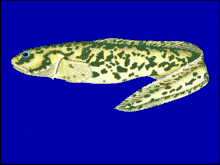| Lycodichthys | |
|---|---|
 | |
| Lycodichthys antarcticus | |
| Scientific classification | |
| Domain: | Eukaryota |
| Kingdom: | Animalia |
| Phylum: | Chordata |
| Class: | Actinopterygii |
| Order: | Scorpaeniformes |
| Family: | Zoarcidae |
| Subfamily: | Lycodinae |
| Genus: | Lycodichthys Paul Pappenheim, 1911[1] |
| Type species | |
| Lycodichthys antarcticus Pappenheim, 1911[2] | |
| Synonyms[3] | |
| |
Lycodichthys is a genus of marine ray-finned fish belonging to the family Zoarcidae, the eelpouts. They are found in the Southern Ocean.
Taxonomy
Lycodichthys was first proposed as a monospecific genus in 1911 by the German zoologist Paul Pappenheim when he described L. antarcticus giving its type locality as the Gauss winter station on the coast of Kaiser Wilhelm II Land in Antarctica.[2][4] The American ichthyologist Hugh Hamilton DeWitt described Rhigophila dearbornii in 1962 but in 1988 this taxon was reviwed by the South African based American ichthyologist M. Eric Anderson and reclassified as the second species in Lyodichthys, making Rhigophila as synonym of Lycodichthys.[5] This genus is classified in the subfamily Lycodinae, one of four subfamilies in the family Zoarcidae, the eelpouts.[6]
Etymology
Lycodichthys combines the name of the Northern genus Lycodes with ichthys, meaning "fish", as this genus closely resembles Lycodes in the shape of the body and fins.[7]
Species
Lycodichthys contains the following species:[8]
- Lycodichthys antarcticus Pappenheim, 1911
- Lycodichthys dearborni (DeWitt, 1962)
Characteristics
Lycodichthys eelpouts have robust bodies which have a depth which is equal to 8.4% to 12.7% of their standard length. They have firm, thick skin and both scales and the lateral line are present. Pelvic fins can be either present or absent. There are five suborbital bones and five pores on the head. The gill slit does not typically extend as far as the lower edge of the base of the pectoral fin. There are no vomerine or palatine teeth.[5] Both species within Lyodichthys are similar in sizee with maximum published of 24 cm (9.4 in) for L. antarcticus and 23 cm (9.1 in) for L. dearbornii.[8]
Distribution and habitat
Lycodichthys are endemic to the waters of the SOuthern Ocean off Antarctica, L. antarcticus occurs from the northern tip of the Antarctic Peninsula east as far as Wilkes Land being dound at deptsh between 195 and 540 m (640 and 1,772 ft) while L. dearborni has onlyu been recorded from the Ross Sea at depths between 550 and 588 m (1,804 and 1,929 ft),[5]
References
- ↑ Bisby F.A., Roskov Y.R., Orrell T.M., Nicolson D., Paglinawan L.E., Bailly N., Kirk P.M., Bourgoin T., Baillargeon G., Ouvrard D. (red.) (2011). "Species 2000 & ITIS Catalogue of Life: 2011 Annual Checklist". Species 2000: Reading, UK. Retrieved 24 September 2012.
{{cite web}}: CS1 maint: multiple names: authors list (link) - 1 2 Eschmeyer, William N.; Fricke, Ron & van der Laan, Richard (eds.). "Genera in the family Lycodinae". Catalog of Fishes. California Academy of Sciences. Retrieved 9 November 2022.
- ↑ "Lycodichthys". WoRMS. World Register of Marine Species. Retrieved 11 November 2022.
- ↑ Eschmeyer, William N.; Fricke, Ron & van der Laan, Richard (eds.). "Species in the genus Lycodichthys". Catalog of Fishes. California Academy of Sciences. Retrieved 11 November 2022.
- 1 2 3 M. Eric Anderson (1994). "Systematics and Osteology of the Zoarcidae (Teleostei: Perciformes)". Ichthyological Bulletin of the J.L.B. Smith Institute of Ichthyology. 60.
- ↑ Anderson , M. E. and V. V . Fedorov (2004). "Family Zoarcidae Swainson 1839 — eelpouts" (PDF). California Academy of Sciences Annotated Checklists of Fishes. 34.
- ↑ Christopher Scharpf & Kenneth J. Lazara, eds. (6 May 2022). "Order Perciformes Suborder Cottoidea: Infraorder Zoarcales: Family: Zoarcidae". The ETYFish Project Fish Name Etymology Database. Christopher Scharpf and Kenneth J. Lazara. Retrieved 11 November 2022.
- 1 2 Froese, Rainer and Pauly, Daniel, eds. (2022). Species of Lycodichthys in FishBase. June 2022 version.